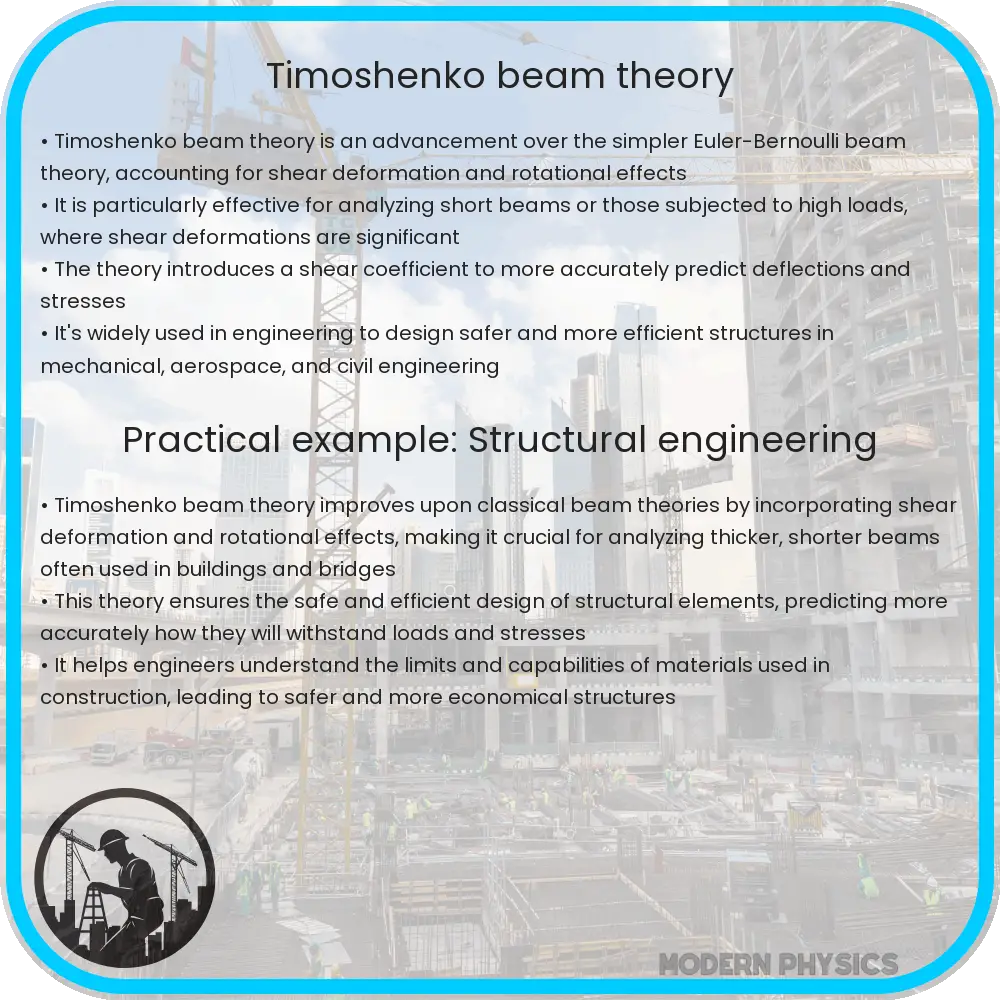Explore Timoshenko Beam Theory: its role in structural analysis, impact on material science, limitations, and applications in modern engineering.

Understanding Timoshenko Beam Theory: An Overview
Timoshenko Beam Theory, named after Stephen Timoshenko, is a significant advancement in the field of structural analysis. It extends the classic Euler-Bernoulli beam theory by incorporating shear deformation and rotational effects, offering a more comprehensive understanding of beam behavior under various loading conditions. This theory is particularly relevant in scenarios where beams have a short span or are made of materials with a low modulus of elasticity.
Key Concepts of Timoshenko Beam Theory
The Timoshenko Beam Theory is grounded in two fundamental concepts: the inclusion of shear deformation and the effect of rotary inertia. These factors become crucial when dealing with beams that are thick, short, or subjected to high-frequency dynamic loading. The theory accounts for the fact that, unlike in Euler-Bernoulli theory, cross-sections of the beam do not remain plane or perpendicular to the neutral axis after deformation. This results in more accurate predictions of deflections and stresses in beams under various loads.
Statics and Flexibility in Timoshenko Beam Theory
From a statics perspective, the Timoshenko Beam Theory allows for the calculation of bending moments, shear forces, and deflections with increased accuracy, especially in short beams where shear deformations are significant. The flexibility of a beam, as predicted by this theory, takes into account both bending and shear flexibility. This dual consideration is essential for precise structural analysis and design, particularly for beams made of materials like polymers and composites, where shear effects cannot be neglected.
Precision in Structural Analysis
The precision of the Timoshenko Beam Theory lies in its ability to model real-world scenarios more accurately than its predecessors. For instance, in dynamic analysis, the theory’s incorporation of rotary inertia effects makes it superior for analyzing the response of beams subjected to dynamic and high-speed loads. It is especially useful in the design of machinery parts, aerospace structures, and other applications where precision is paramount.
Furthermore, the adaptability of the Timoshenko Beam Theory to various boundary conditions and load types makes it a versatile tool in structural engineering. Whether dealing with fixed, simply supported, or cantilever beams, this theory provides a robust framework for analysis.
In conclusion, the Timoshenko Beam Theory marks a significant step forward in the field of structural engineering, providing engineers with a more nuanced and accurate tool for analyzing beam behavior. Its ability to account for shear deformation and rotary inertia effects ensures that it remains a vital part of modern engineering analysis and design.
Applications and Advancements
The application of Timoshenko Beam Theory extends beyond traditional civil engineering. Its principles are also applied in mechanical and aerospace engineering, particularly in the design of components where precision and flexibility are crucial. With ongoing advancements in computational methods and material science, the theory continues to evolve, offering even more precise and efficient ways to analyze and design complex structures.
Advanced Computational Methods and Material Science
With the advent of advanced computational tools, the Timoshenko Beam Theory has seen significant enhancements in its application. Modern finite element methods (FEM) allow for the detailed analysis of complex structures using Timoshenko’s principles. These computational models can handle varying cross-sectional geometries, material properties, and complex loading conditions, providing engineers with precise insights into the structural behavior of beams and other elements.
Impact on Material Science
In material science, the Timoshenko Beam Theory plays a critical role in understanding and predicting the behavior of new materials and composites. By incorporating shear deformation and rotational inertia, engineers can more accurately predict how these materials will behave in real-world applications, leading to safer and more efficient designs. This is particularly important in the aerospace industry, where weight savings are essential, and materials are often pushed to their limits.
Limitations and Considerations
While the Timoshenko Beam Theory is a powerful tool, it is not without limitations. The theory assumes linear material behavior and may not accurately predict the behavior of beams under extremely high stress or in non-linear material conditions. Additionally, the increased complexity of the theory, compared to the simpler Euler-Bernoulli model, can lead to more complex calculations and the need for advanced computational resources.
Conclusion: The Significance of Timoshenko Beam Theory in Modern Engineering
The Timoshenko Beam Theory has revolutionized the field of structural analysis by providing a more accurate and comprehensive framework for understanding beam behavior. Its incorporation of shear deformation and rotary inertia effects allows for precise predictions in a variety of applications, from civil engineering to aerospace design. The theory’s adaptability to modern computational methods and its relevance in material science further underscore its importance in contemporary engineering. Despite its complexity and certain limitations, the Timoshenko Beam Theory remains a cornerstone in structural engineering, offering invaluable insights and solutions in the design and analysis of various structures. As technology and materials continue to advance, the theory’s applications and significance are poised to expand, further enhancing its role in shaping the future of engineering.
